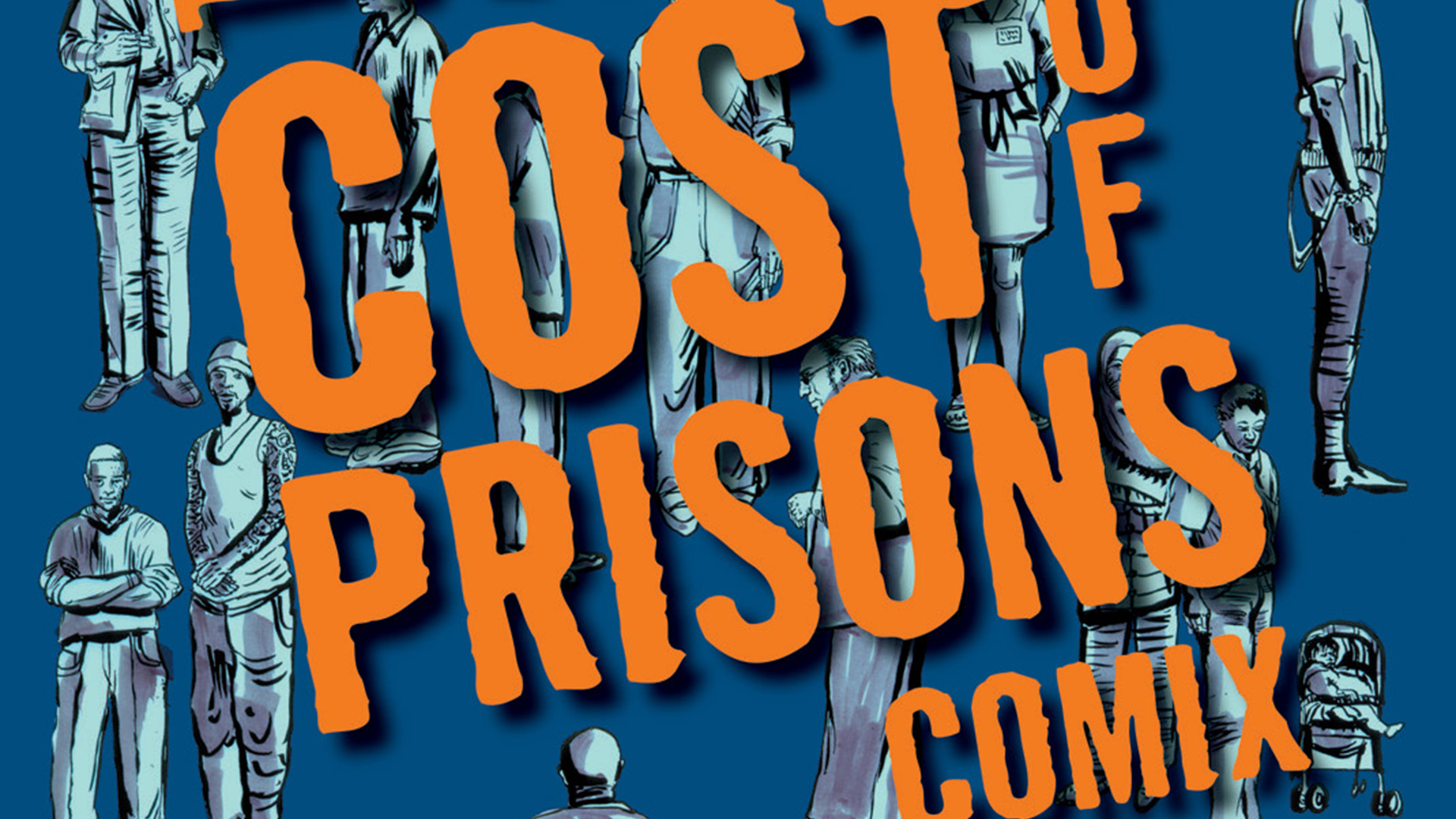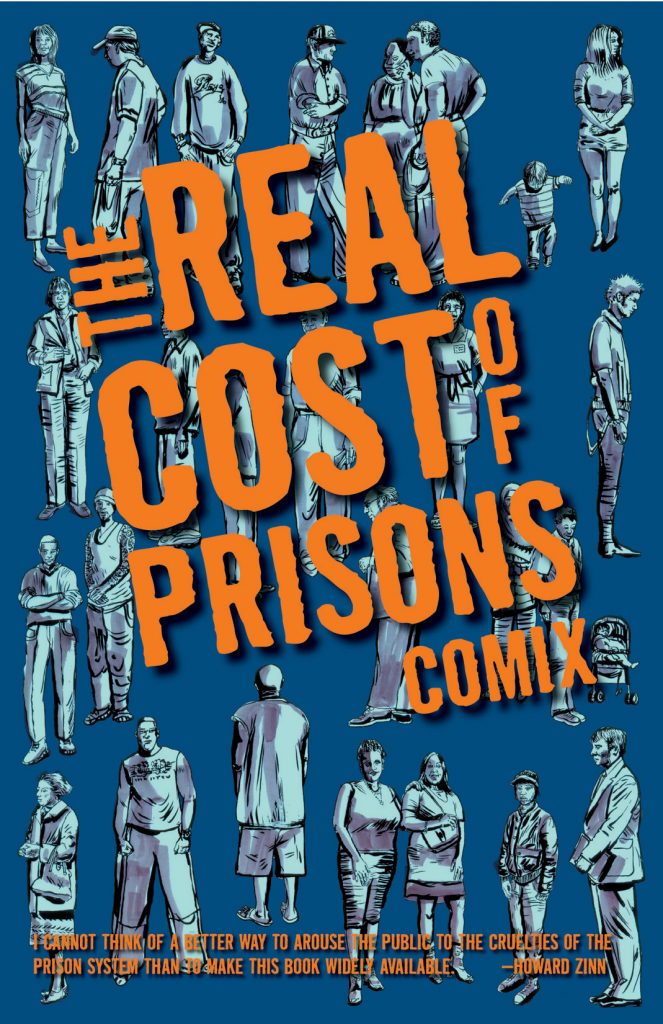Lessons in the Real Cost of Prisons
By Jordan Beltran Gonzales
Changing Lives, Changing Minds
This
anthology combines three engaging and educational comics with dozens of
letters and testimonials from readers. Fewer than 100 pages yield a
thorough breakdown of how America’s economic and social addiction to
imprisoning Black, Brown, and poor people for particular behaviors has
spiraled into an epidemic of mass incarceration. Through vivid
black-and-white images, well-researched background information, and case
studies of women and men in context, readers gain vital knowledge and
access to progressive networks that will transform this crisis.
Today, more than 2.3 million women and men are currently locked up, while more than 5 million people also endure state surveillance and a multitude of legal and social obstacles while on parole or probation. One of every 32 adults is in this matrix. One in five children of women who become incarcerated will directly witness their mother’s arrest. Half of all women in prison are incarcerated more than 100 miles from their families. This book represents an urgent struggle for our present and future generations.
To combat this hydra of racialized drug policies, greed and exploitation of prison towns, and the skyrocketing rates of incarceration of women, a coalition of writers and artists offer models of popular education and share their visions for drug treatment, harm reduction, and justice reinvestment. The task of critical storytelling and teaching about life-and-death issues in this social movement is a careful balance, which the writers and artists achieve admirably. In each comic, readers find alternative solutions to prisons as we currently know them, learn about organizing successes, and gain feedback of how to teach teachers and how to train trainers.
Editor Lois Ahrens is also the founder and director of the Real Cost of Prisons Project, which creates popular educational materials by justice policy researchers, artists, and people directly experiencing the impact of mass incarceration. In the preface, Ahrens emphasizes the importance of this book’s access and usefulness across all audiences. In fact, the comics are direct products of the Real Cost of Prisons Project educational workshops about public health, popular economics, and progressive reform and abolition. Potential readers span elementary schools through colleges, community-based organizations, medical and mental healthcare providers, legislators and voters, and people directly surviving inside.
In the introduction, Ruth Wilson Gilmore and Craig Gilmore compel readers to translate knowledge into action. This book helps us understand “how the system of mass incarceration permeates our lives, who is paying the costs of that system and the many ways the system is vulnerable to people who put their thought and effort into organizing to shrink it.”
The first chapter, “Prison Town: Paying the Price,” by Kevin Pyle and Craig Gilmore, explains the economic greed and political collusion inherent in the siting of prisons. Case studies across the U.S. reveal environmental injustices, racism in English-only and anti-immigrant business and legal maneuvers, and the destruction of local economies, all stemming from prison towns’ misnamed “community development projects.” Following this chapter are eye-opening testimonials, in which one program director applauds this comic through “the complexity that is rendered through a few deceptively simple strokes of a pen.”
In “Prisoners of the War on Drugs,” Sabrina Jones, Ellen Miller-Mack, and Lois Ahrens highlight the relationships across drug policies, racialized perceptions of crime and criminality, and, after incarceration, limited access to social services and educational opportunities. Five case studies present an individual person’s life context for a momentary decision. This context is necessary for readers to understand the persistence of institutional racism and barriers for people of color and, in particular, women and mothers. Alternatives to New York’s Rockefeller Drug Laws and California’s Three Strikes Law include programs in harm reduction, which reduce the harmful effects of drug use on families, and justice reinvestment, which supports jobs, housing, quality schools, and youth programs.
The final chapter, “Prisoners of a Hard Life: Women and Their Children,” by Susan Willmarth, Ellen Miller-Mack, and Lois Ahrens, exposes the subjective and violent enforcement of drug laws against women, specifically low-income women of color. Five individual women’s stories show how poverty, access to life chances, police targeting, and court sentencing have usurped hundreds of thousands of women’s reproductive rights. This comic’s closing pages feature excellent alternatives to jail through the theme “Change Is Possible.”
As an instructor of Ethnic Studies College Writing, I attest to the effectiveness of these comics. With the goal of critically informing my high school students about the prison industrial complex and the built-in tracking in our high school to college pipeline, I have challenged students to teach each other key themes and terms from the comics. Their group presentations were phenomenal, and far more impressive than my typical college students’ work! They took ownership of the process of recidivism and the injustice of mandatory minimum sentences, as well as reflected the ever-important sense of agency and social responsibility to affect this same system that is targeting our low-income communities of color.
My students have often told me that they have felt validated and affirmed to finally identify a name, a theory, and a matrix of issues related to their life experiences. These comics urge us to remember that we are not alone, either in our struggle or in our imagination for something better. Teaching with the Real Cost of Prisons Comix has been one of the most meaningful experiences I have had as an educator. I absolutely recommend this book as an assigned text in courses that bridge issues of media, American Studies, social justice, critical thinking, educational inequities, and the cross-cutting themes of gender, race, and class. Our potential for learning is limitless, and there is no time more urgent than now.
Jordan Beltran Gonzales is a Ph.D. candidate in the Department of Ethnic Studies at UC Berkeley. He teaches courses in critical thinking, U.S. counter-history, research methods, and academic survival with high school and college students. He believes in justice through education, home-cooked food, and live music. Your words are welcomed at [email protected]







